Mobility Matters - 2020 Winter
Try Parking It Relaunched with More Functionality
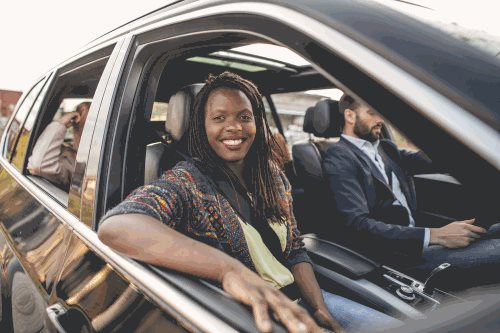
Photo: Getty Images
Sharing a ride is one way commuters, students and shoppers can contribute to a more reliable transportation system and cleaner North Texas. Try Parking It, the region's rideshare and alternative-commute program, has been relaunched with increased functionality.
The Dallas-Fort Worth area’s alternative-commute and rideshare website has been updated.
The new TryParkingIt.com still allows users to find rideshare matches and record their alternatives to driving alone in return for earning rewards. But there are now improved functionalities that make the experience more personalized and seamless.
For example, residents who vanpool, carpool or take transit to work used to have to track their commute alternatives after every trip. Now, they can now mark their choices as recurring trips, meaning they don’t have to enter them each time. This saves time and can lead to more accurate records, since people must no longer remember to enter trips every time they are taken.
Try Parking It also offers a mobile app, allowing people to participate wherever they are. They can also sign up for text or email alerts.
The previous app must be deleted and the new one downloaded before users are able to experience the increased functionality. Once installed, it holds new possibilities.
Whether recorded on the website or app, each alternative commute can earn points toward an expanded list of rewards, including raffles, dining, shopping, activities and services. By establishing a new account, users of the app and website begin with 1,000 points. Those points can either be instantly redeemed for an expanded list of rewards or saved for later.
Many of the trips saved by Try Parking It users have been commutes to and from work. But the program also encourages people to track other instances where they do not drive alone – shopping, dining, etc. They can even record physical activity, such as bicycling, walking and running.
For example, users of the Strava and Under Armour fitness apps can enter their activities and have them count on Try Parking It. This feature only works when people are traveling somewhere. The idea is to promote alternatives to driving alone for all trips, not just commutes to and from the office.
An agreement with Enterprise to maintain vanpool information means Try Parking It can offer a more accurate list of available vanpools, which will be automatically updated. When users log on to find a vanpool match, the list will be current.
To get started, visit www.tryparkingit.com or download the FREE Try Parking It app from the App Store or on Google Play.
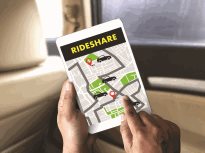
Photo: Getty Images
Try Parking It can be accessed online
or via a free mobile app. Users have
more flexibility with the program's
relaunch, completed in 2019.
Try Parking It has allowed residents to track their alternatives to driving alone for more than 10 years. In a region growing as quickly as Dallas-Fort Worth, alternatives to driving alone are becoming increasingly important. Try Parking It is one way for people to contribute to the increased reliability of the system – and earn rewards while doing so.
Students Could Prove Integral to Introduction of High-Speed Transportation
A message from Michael Morris, P.E., Director of Transportation
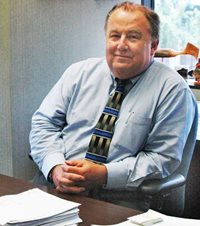
Michael Morris, P.E.
Students from around Dallas-Fort Worth huddle together on the field of AT&T Stadium, listening intently to the directions given. But they are not coming from a quarterback and there is no football game to be played on this summer afternoon.
Instead, the students are learning about friction, vacuum chambers, magnetic levitation and things that sound a lot like what may be taught in science class. Representatives from Virgin Hyperloop One are demonstrating the principles behind the ultra-fast hyperloop technology that could come to our region in a matter of years.
The Dallas-Fort Worth area was privileged to welcome a team from Virgin Hyperloop One to Arlington as part of the company’s roadshow this summer. The trip included opportunities to discuss the technology with public officials and show the VHO representatives what makes North Texas the right place for a certification track that may one day carry actual passengers as part of a full-scale hyperloop operation.
Hyperloop is a new mode of transportation that could move freight and people quickly, safely, and on-demand from origin to destination. Hyperloop vehicles, called pods, accelerate gradually via electric propulsion through a low-pressure tube.
It was important to us to make students a central focus of the VHO trip. It is essential to involve public- and private-sector officials from a variety of levels in the planning process. We are doing that now and will continue to do so until this dream becomes a reality.
But we had a unique opportunity to bring students into the conversation about a technology they may one day be working on. The pod was right there on the field for everyone to see, helping them visualize how the hyperloop might employ the principles they were learning to transport them from one end of the region – or State – to the other in a matter of minutes.
For the hyperloop to come to fruition, as we believe it can, people with the right mix of idealism and realism will have to take the concept of maglev-driven transportation and make it a reality. Who better to do this than today’s brightest students? They are the future engineers, mathematicians and scientists who will develop the innovations capable of keeping the region prosperous.
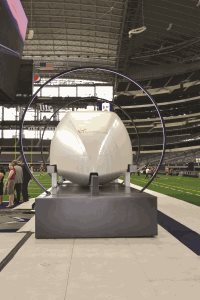
Photo: NCTCOG
Virgin Hyperloop One brought
its futuristic pod to Arlington,
allowing students and community
leaders to experience up-close
what the future in transportation
might look like.
Hyperloop is one option for moving people through the region and beyond quickly and efficiently, something that will grow in importance as we continue to add more than 1 million new residents each decade. High-speed rail is another possibility. Texas Central Partners is working to bring high-speed trains to the busy corridor between Dallas and Houston. That technology could be built to link Dallas, Arlington and Fort Worth. Or hyperloop may be the answer.
NCTCOG has released a request for proposals seeking firms to study the environmental impacts of both forms of transportation. Both possibilities hold promise, and we want to make sure we select the mode that works best for our region. The goal is to identify a solution that enhances our transportation system and connects Dallas-Fort Worth with other high-performance systems. A consultant will be selected in the spring. The winning bidder will conduct an alternatives analysis, preliminary engineering and environmental studies for the possible implementation of high-speed transportation between Dallas, Arlington and Fort Worth.
Whatever the result, our workforce will be ready to contribute the knowledge and skills necessary to bring high-speed transportation to North Texas. It helps to have bright, naturally curious students capable of taking the concepts we're talking about and seamlessly integrating them into the transportation system so we can reliably move people and goods throughout the region for decades to come. After all ... the future matters.
NDEW Draws Almost 200 Electric Vehicles in Irving
Electric vehicles continue to grow in popularity in Dallas-Fort Worth. There are currently nearly 13,000 EVs registered in North Texas, an exponential increase since 2011, when there were only a little more than 200.
These quiet, clean-burning alternatives to gasoline-powered cars and trucks were celebrated in Irving this fall during the region’s annual National Drive Electric Week event. And with the help of enthusiastic vehicle owners, volunteers and exhibitors, NDEW 2019 established a new Texas record.
There were 186 EVs gathered in one location, improving upon the previous mark set last year. Nearly every EV make and model was represented at the event, giving attendees a chance to experience all shapes sizes, and price points. There were even two-wheeled options on display, including the Harley-Davidson Livewire. Talented high schoolers from The Winton School came with their solar-powered car to show that the future is truly in good hands.
The DFW event was one of more than 200 celebrations across the US, Canada and Mexico. NDEW started in 2011 as National Plug In Day, later expanding to an entire week, putting these innovative and environmentally friendly transportation alternatives. For more on EVs in Dallas-Fort Worth and their impact, visit www.dfwcleancities.org/evnt.
Williams Embraces Promise of Transportation Innovation
When Jeff Williams and his wife chose to move to Arlington, it didn’t take long for him to realize the importance of transportation and how it impacted the lives of his neighbors. The civil engineer had had an interest in mobility for a long time, but in Arlington, he began to see how crucial reliability was in a region the size of Dallas-Fort Worth.
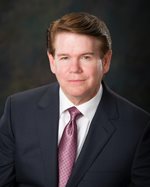
Jeff Williams, P.E.,
mayor of Arlington
Then, in 2015, he was elected to the city’s top job.
“When I became mayor, I got really excited because I had been studying the different modes of transportation that were ahead of us,” Williams said. “Suddenly, we are going to have new transportation options that we have never had, and we are at the beginning of a transportation technology revolution.”
Williams pointed to the testing of the Milo autonomous shuttle in the Entertainment District, saying the city wanted to help people realize new inventions are coming. Residents embraced the technology before Arlington welcomed Drive.ai for a pilot involving autonomous vehicles on public streets.
“We’ve proven the technology. The technology has been proven,” he said. “We’ve also proven, I think, the fact that our citizens can be adaptive and be willing to accept change in transportation modes.”
These successful pilot projects sent a message to other parts of the country and the world that Arlington is a good place to test other innovations, he said.
“We’ll test it fast to see if it works,” he said. “If it works, we’ll use it. If it doesn’t we’ll move on to the next thing.”
One of the latest things is high-speed transportation technology, and Arlington could serve as a testing ground for hyperloop, the ultra-fast vehicle that would travel using magnetic levitation.
“We’re known as the can-do city that can make things happen,” he said. “And probably a foundation of that is the University of Texas at Arlington.”
Williams serves as president of Arlington-based Graham Associates, an Arlington-based engineering firm that has had a hand in many of the city’s signature facilities. Among them are Globe Life Park, AT&T Stadium and the Three Bridges Project.
He was able to take lessons he learned from working on these and other projects and apply them to regional transportation decision-making when he joined the Regional Transportation Council in 2015.
“When we were working on AT&T Stadium, one of the important things we had to do was make sure we could get people in and out,” he said.
They studied stadiums across the US and applied many of the principles they learned from the nation’s best to help make sure the Arlington stadium could operate efficiently.
“For any special event taking place at the stadium, you’ve got to continue to maintain the normal flow of traffic,” he said. “And you still have to deal with the rush-hour traffic if it’s a week day because that can happen to you in the morning and afternoon.”
Many people may focus on the big athletic events that occur at AT&T Stadium. But Williams said the stadium hosts 300 events a year.
This makes things challenging, he said, but through the analysis of the traffic patterns and encouraging people to use the numerous interchanges in the area, they can move people in and out of the area efficiently.
One of his favorite things to work on was The Three Bridges Project, which involved transforming a roadway that had served as a tollway to a modern facility – with frontage roads – that operates more efficiently, he said.
As a member of the RTC, Williams works with colleagues from across the region who all have a responsibility to serve their own constituents. But to accomplish big tasks, a broader perspective is required.
“The cooperation and partnerships that are created there in RTC are critical,” he said, ”because transportation doesn’t take place in a silo. And it doesn’t pay any attention to city limit lines. So, it’s very important that we work as a region and we work together to promote great transportation.”
One thing that has encourages Williams is the RTC’s innovation. Policymakers are not just looking at roads, but other methods to improve mobility in the nation’s fourth-largest metropolitan area.
He pointed to a pilot project in cooperation with General Motors to use an autonomous train to move completed SUVs over State Highway 360 to the railroad depot so the company’s vehicles can be moved to market. When not being used by GM, the technology could be tested by passengers, he said.
He thinks it could be the new wave in public transportation, replacing older methods because it could move people and goods less expensively.
“Literally, this could be a method of transportation that could transport products and passengers at about an 80% reduction in cost.”
The RTC has affirmed the concept, and the next step is implementation.
Whether as mayor, the leader of an engineering firm or a transportation policymaker, Williams is applying the principles he has learned throughout his career to help his neighbors in Arlington and people across the region move efficiently.
NCTCOG eyes proposals for high-speed study
High-speed transportation in North Texas has drawn interest from everyone from students to planners, policymakers to industry professionals. The idea of traveling between Dallas and Fort Worth in less than 10 minutes appeals to people in an area experiencing some of the most intense growth in the country. The Dallas-Fort Worth area has a population of 7.5 million today, and if trends continue, will be home to more than 11 million by 2045.
That calls for a transportation system with many choices for people needing to get around for work, school, medical appointments or recreation. While high-speed transportation would be another option in the region, it may also serve as a gateway to other parts of Texas.
What the high-speed transportation will look like is expected to become clearer soon. The North Central Texas Council of Governments has released a request for proposals for firms interested in developing and evaluating technologies and alignments, as well as documenting these efforts through the National Environmental Policy Act (NEPA) process for the Dallas-Fort Worth corridor. The alignment would include Arlington and Dallas Fort Worth International Airport. NCTCOG, the Federal Railroad Administration and the Federal Transit Administration will administer this study.
The selected consultant will provide technical support for the analysis of potential alternatives, operations/service planning and preliminary engineering and environmental documentation for high-speed passenger service between Dallas and Fort Worth. Firms interested in studying the Dallas-Fort Worth corridor have submitted proposals to NCTCOG. NCTCOG staff will evaluate the proposals and present a recommendation to the NCTCOG Executive Board, which could select the consultant in April.
NCTCOG is developing a two-phase high-speed technology work plan intended to bring a form of this new transportation to the region. The process is expected to last approximately three years.
Phase I will involve the alternatives analysis, some engineering and data collection. Phase II will include the NEPA analysis, where the impacts to the built, natural and social environments will be studied. One goal of NEPA is to make sure new assets can be constructed fairly and equitably, without disproportionately affecting any specific groups. The work plan will guide NCTCOG as it leads the public engagement process.
Several potential transportation options exist for the corridor, including high-speed rail and hyperloop technology. With Texas Central’s work in the Dallas-to-Houston Corridor, there is already an effort to bring high-speed rail to Texas. Hyperloop technology was demonstrated in Arlington as part of a national tour by Virgin Hyperloop One over the summer, and the company is considering the region to house a certification facility.
Whatever option is selected should enhance the regional transportation system and connect the metropolitan area with other proposed high-performance passenger systems in Texas. A consultant is currently studying the feasibility of bringing high-speed transportation to the Fort Worth-to-Laredo corridor.
Important Regional Roadway Projects Getting Started in 2020
Significant roadway projects on both sides of the Dallas-Fort Worth area are moving forward. LBJ East, an 11-mile stretch of Interstate Highway 635 through, Dallas, Garland and Mesquite, is expected to be underway in early 2020.
The Regional Transportation Council and State worked together on an agreement to improve capacity of the roadway, originally built more than 50 years ago. Ultimately, LBJ East will be expanded from the current four main lanes in each direction to five main lanes in each direction between US Highway 75 and Interstate Highway 30.
The current single tolled managed lane in each direction of LBJ East is grandfathered and will be rebuilt. The IH 30 interchange also will be rebuilt and improved. Another important feature of the LBJ East project is the construction of continuous frontage roads throughout the project, which will greatly enhance safety and mobility by improving the flow of traffic during major incidents.
The Texas Department of Transportation also partnered with the City of Dallas to reconfigure the Skillman/Audelia interchange as part of the project. That interchange will feature aesthetic elements to the bridge over LBJ Freeway. It was designed by the City of Dallas and was selected for funding by the RTC. The project represents the second major improvement to IH 635 in recent years. The $2.6 billion LBJ Express resulted in the reconstruction and expansion of 13 miles of the interstate in 2015.

Photo: Getty Images
Significant roadway projects will be underway across the
Dallas-Fort Worth area in 2020. Two of them will address
mobility in Fort Worth (IH 35W) and Dallas County
(LBJ East). Cooperation and partnerships helped both
move forward.
On the western side of the region, the final segment of 35W Express, a project that has introduced greater mobility to the heart of Tarrant County, is also moving forward.
The $910 million project to rebuild 6.7 miles of IH 35W from just north of US 81/287 (Heritage Trace Parkway) to Eagle Parkway in Denton County reached financial close over the summer. Pre-construction activities are underway, with full construction planned to commence next year, according to NTE Mobility Partners Segments 3 LLC, which will finance, design, build, operate and maintain the segment. When the project is complete, in 2023, motorists will benefit from reconstructed main lanes, expanded frontage roads and two TEXpress Managed Lanes in each direction.
The section of IH 35W being rebuilt connects with two other portions of the roadway operated by NTE. Segment 3C will complement the existing network of TEXpress Managed Lanes and add to the congestion relief being experienced now by drivers throughout North Texas. These projects will improve traffic flow through two of the busiest sections of the Dallas-Fort Worth area. Both demonstrate the importance of cooperation between the regional and State levels to develop solutions to keep people moving.
